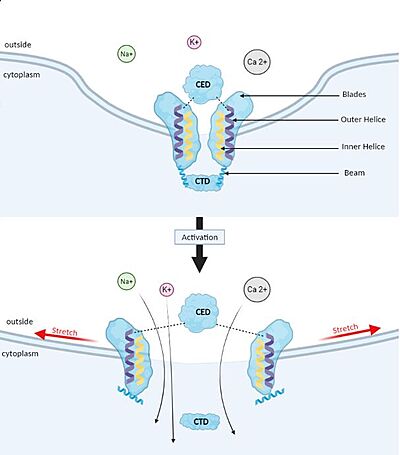Sandbox Reserved 1653
From Proteopedia
(Difference between revisions)
| Line 96: | Line 96: | ||
== Diseases == | == Diseases == | ||
| - | [https://en.wikipedia.org/wiki/Hereditary_stomatocytosis Dehydrated hereditary stomatocytosis] (DHS) is a genetic disease with impaired red blood cell (RBC) membrane properties that affect intracellular cation concentrations.<ref name="Dehydrated"> DOI 10.1038/ncomms2899</ref> The RBCs are abnormally shaped and they result in [https://en.wikipedia.org/wiki/Hemolytic_anemia haemolytic anaemia]. Piezo1 is expressed in the plasma membranes of RBCs, and its role is to control RBCs’ osmolarity. It also plays a prevalent role in the [https://en.wikipedia.org/wiki/Erythropoiesis erythroid differentiation]. Mutations in Piezo1 distort mechanosensitive channel regulation, leading to increased cation transport in erythroid cells. | ||
| - | + | Because Piezo1 is implicated in the functioning of many cells and organs, modifications on its structure lead to diseases. For instance, Hereditary Xerocytosis (HX) is a rare disease, also called [https://en.wikipedia.org/wiki/Hereditary_stomatocytosis Dehydrated hereditary stomatocytosis] (DHS). This genetic disease leads to impaired red blood cell (RBC) membrane properties that affect intracellular cation concentrations.<ref name="Dehydrated"> DOI 10.1038/ncomms2899</ref> The RBCs are abnormally shaped and they result in [https://en.wikipedia.org/wiki/Hemolytic_anemia haemolytic anaemia]. Those modifications are due to mutations on the FAM38A gene on chromosome 16 which encodes for Piezo 1. Piezo1 is expressed in the plasma membranes of RBCs, and its role is to control RBCs’ osmolarity. It also plays a prevalent role in the [https://en.wikipedia.org/wiki/Erythropoiesis erythroid differentiation]. Mutations in Piezo1 distort mechanosensitive channel regulation, leading to increased cation transport in erythroid cells. Six gain-of-function mutations, gathered in the central core region of the Piezo channel structure, are directly linked to the decrease of inactivation rate of the channel. | |
| + | Those mutations could provoke increases in permeability of cations in RBC by different mechanisms. It could induce mechanically activated currents that inactivate more slowly than wild-type currents. They could also affect the inactivation process by either destabilising the inactivated state or stabilising the channel in the open state. As a result, the open to inactivated state equilibrium shifts towards open. Na+ and Ca2+ ion influx consequently increase, and the intracellular K+ concentration decreases in a steady state. The evolution of Piezo1’s function steams from a change in its 3D structure. | ||
| + | |||
== Potential therapeutic target == | == Potential therapeutic target == | ||
Revision as of 13:25, 14 January 2022
| |||||||||||
References
- ↑ 1.0 1.1 1.2 Zhao Q, Wu K, Geng J, Chi S, Wang Y, Zhi P, Zhang M, Xiao B. Ion Permeation and Mechanotransduction Mechanisms of Mechanosensitive Piezo Channels. Neuron. 2016 Mar 16;89(6):1248-1263. doi: 10.1016/j.neuron.2016.01.046. Epub 2016, Feb 25. PMID:26924440 doi:http://dx.doi.org/10.1016/j.neuron.2016.01.046
- ↑ 2.0 2.1 Parpaite T, Coste B. Piezo channels. Curr Biol. 2017 Apr 3;27(7):R250-R252. doi: 10.1016/j.cub.2017.01.048. PMID:28376327 doi:http://dx.doi.org/10.1016/j.cub.2017.01.048
- ↑ 3.0 3.1 3.2 Zhou, Z. (2019). Structural Analysis of Piezo1 Ion Channel Reveals the Relationship between Amino Acid Sequence Mutations and Human Diseases. 139–155. DOI 10.4236/jbm.2019.712012
- ↑ 4.0 4.1 4.2 4.3 4.4 Zhao Q, Zhou H, Chi S, Wang Y, Wang J, Geng J, Wu K, Liu W, Zhang T, Dong MQ, Wang J, Li X, Xiao B. Structure and mechanogating mechanism of the Piezo1 channel. Nature. 2018 Feb 22;554(7693):487-492. doi: 10.1038/nature25743. Epub 2018 Jan, 22. PMID:29469092 doi:http://dx.doi.org/10.1038/nature25743
- ↑ 5.0 5.1 5.2 5.3 Liang X, Howard J. Structural Biology: Piezo Senses Tension through Curvature. Curr Biol. 2018 Apr 23;28(8):R357-R359. doi: 10.1016/j.cub.2018.02.078. PMID:29689211 doi:http://dx.doi.org/10.1016/j.cub.2018.02.078
- ↑ 6.0 6.1 Guo YR, MacKinnon R. Structure-based membrane dome mechanism for Piezo mechanosensitivity. Elife. 2017 Dec 12;6. pii: 33660. doi: 10.7554/eLife.33660. PMID:29231809 doi:http://dx.doi.org/10.7554/eLife.33660
- ↑ 7.0 7.1 7.2 Ge J, Li W, Zhao Q, Li N, Chen M, Zhi P, Li R, Gao N, Xiao B, Yang M. Architecture of the mammalian mechanosensitive Piezo1 channel. Nature. 2015 Nov 5;527(7576):64-9. doi: 10.1038/nature15247. Epub 2015 Sep 21. PMID:26390154 doi:http://dx.doi.org/10.1038/nature15247
- ↑ 8.0 8.1 Saotome K, Murthy SE, Kefauver JM, Whitwam T, Patapoutian A, Ward AB. Structure of the mechanically activated ion channel Piezo1. Nature. 2017 Dec 20. pii: nature25453. doi: 10.1038/nature25453. PMID:29261642 doi:http://dx.doi.org/10.1038/nature25453
- ↑ 9.0 9.1 Lin YC, Guo YR, Miyagi A, Levring J, MacKinnon R, Scheuring S. Force-induced conformational changes in PIEZO1. Nature. 2019 Sep;573(7773):230-234. doi: 10.1038/s41586-019-1499-2. Epub 2019 Aug, 21. PMID:31435018 doi:http://dx.doi.org/10.1038/s41586-019-1499-2
- ↑ 10.0 10.1 10.2 10.3 10.4 Wei L, Mousawi F, Li D, Roger S, Li J, Yang X, Jiang LH. Adenosine Triphosphate Release and P2 Receptor Signaling in Piezo1 Channel-Dependent Mechanoregulation. Front Pharmacol. 2019 Nov 6;10:1304. doi: 10.3389/fphar.2019.01304. eCollection, 2019. PMID:31780935 doi:http://dx.doi.org/10.3389/fphar.2019.01304
- ↑ Li J, Hou B, Tumova S, Muraki K, Bruns A, Ludlow MJ, Sedo A, Hyman AJ, McKeown L, Young RS, Yuldasheva NY, Majeed Y, Wilson LA, Rode B, Bailey MA, Kim HR, Fu Z, Carter DA, Bilton J, Imrie H, Ajuh P, Dear TN, Cubbon RM, Kearney MT, Prasad KR, Evans PC, Ainscough JF, Beech DJ. Piezo1 integration of vascular architecture with physiological force. Nature. 2014 Nov 13;515(7526):279-82. doi: 10.1038/nature13701. Epub 2014 Aug 10. PMID:25119035 doi:http://dx.doi.org/10.1038/nature13701
- ↑ Albuisson J, Murthy SE, Bandell M, Coste B, Louis-Dit-Picard H, Mathur J, Feneant-Thibault M, Tertian G, de Jaureguiberry JP, Syfuss PY, Cahalan S, Garcon L, Toutain F, Simon Rohrlich P, Delaunay J, Picard V, Jeunemaitre X, Patapoutian A. Dehydrated hereditary stomatocytosis linked to gain-of-function mutations in mechanically activated PIEZO1 ion channels. Nat Commun. 2013;4:1884. doi: 10.1038/ncomms2899. PMID:23695678 doi:http://dx.doi.org/10.1038/ncomms2899

